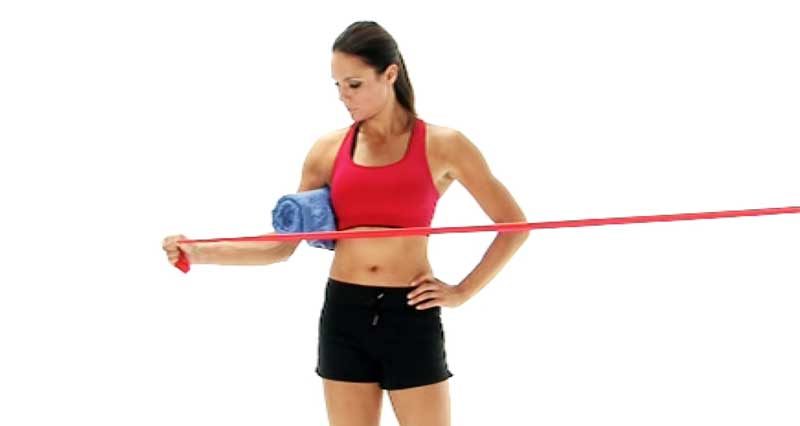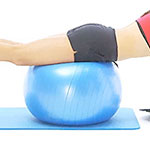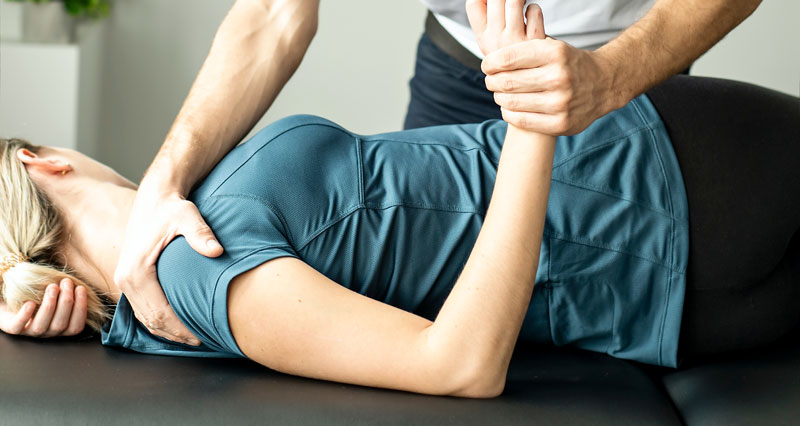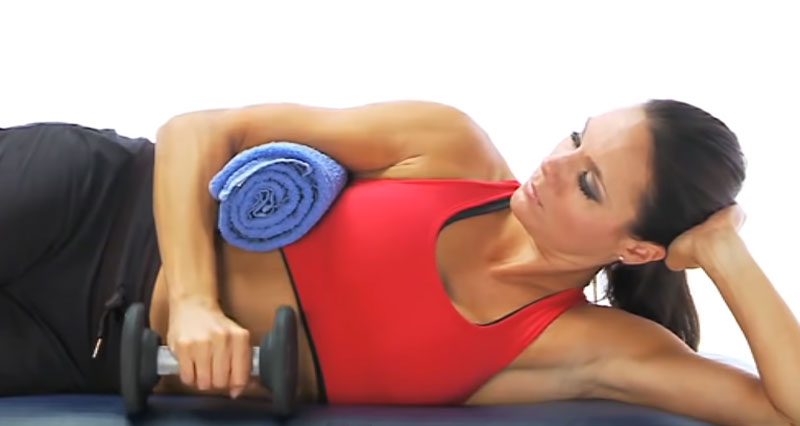This rotator cuff strain rehabilitation program is based on four stages. The acute stage, immediately after injury, recovery stage, functional stage and returning to full fitness.
Rehabilitation of rotator cuff injuries consists of four elements; acute phase (immediately post-injury), recovery phase, functional phase and finally returning to full training and competition.
Phase 1: Acute phase
The acute phase of rotator cuff treatment occurs immediately after the injury occurs and will continue until a pain-free range of motion (below shoulder height) has been achieved and normal daily activities are relatively pain-free.
Aims:
- To allow tissue healing
- Reduce pain and inflammation
- Prevent muscles wasting
- Maintain normal movement in the shoulder blades (scapular control)
- Maintain fitness
Tissue healing
- This involves resting the shoulder to allow tissues to heal. If you are constantly moving the shoulder and causing pain then this will slow down or prevent the healing process.
- Depending on how bad the injury is rest can be active rest where you simply avoid movements or activities which cause pain (specific weight training exercises or racket sports for example), but for more severe rotator cuff tears a sling to immobilize the shoulder joint may be required.
- A professional practitioner may use ultrasound therapy or other electrotherapy modalities to help stimulate the healing process.
Reduce the pain and inflammation
- Apply cold therapy and compression wrap to the shoulder. This will help reduce pain and inflammation.
- Apply ice for up to 15 minutes every 2 hours, gradually reducing the frequency of applications as the shoulder improves. Specialist cold therapy wraps for shoulders apply compression to the area as well. Otherwise, a simple ice pack applied with some pressure will be effective.
- Posture is important and sitting upright with the shoulders back, especially when sitting at a desk or using a computer can help relieve symptoms.
- A doctor may prescribe NSAID’ or anti-inflammatory medication (e.g. ibuprofen) may help in the early stages although it is argued they are not as effective later on or if the injury becomes chronic.
- Always check with your Doctor before taking medication if you are not sure. Again, electrotherapy such as ultrasound may be beneficial to reduce pain and inflammation.
Range of motion
- Mobility exercises to regain range of movement in the shoulder joint should begin as soon as they can be done pain-free. Pendulum exercises are the first priority, especially if it is a serious tear or following surgery.
- However, for mild torn rotator cuff injuries more advanced mobility and stretching exercises using a pole would be progressed onto.
- Professional therapists may use sports massage techniques including cross friction massage to help the athlete regain full range of movement.
- Simply applying pressure to the tendon initially may be all that is needed. As pain reduces, a massage therapist may apply deeper cross-friction techniques.
Read more on rotator cuff exercises.
Strengthening
Isometric or static exercises can begin as soon as they can be done pain-free. However, for a rotator cuff strain, it may not be until later in the rehabilitation process that strengthening exercises can begin. Scapular control exercises such as the scapular squeeze and elevation exercises are important to maintain the correct movement patterns in the shoulder joint as rehabilitation progresses.
Read more on rotator cuff exercises.
Maintaining fitness
Aerobic exercises such as running, cycling or stepping machines should be done to maintain fitness and also psychological well-being. Use the opportunity to focus on other aspects of fitness such as agility, plyometric leg strength or flexibility.
Phase 2: Recovery phase
The recovery phase begins when the initial pain and inflammation have gone and most normal daily activities are pain-free and the injured arm has at least 75% range of movement compared to the uninjured one.
Aims:
- Regain a full, pain-free range of motion
- Normal upper body strength
- Normal shoulder joint movement patterns
Range of motion
This is achieved by wand or pole exercises which help with flexibility above shoulder height progressing onto stretching and mobility exercises without assistance from a pole. Scapular control is progressed with balance board exercises on your hands, press-up type exercises and ball catch and return exercises.
Strengthening
Exercises to isolate the rotator cuff muscles can begin including strengthening exercises which concentrate more specifically on the external rotator muscles (the ones that rotate the arm out) and the scapular stabilisers (muscles that support the shoulder blade). It is also important to strengthen the whole joint and weight training exercises such as bench press, shoulder press (military press) and pulldowns should be done but with very light weights. For example, aiming for 12 to 20 reps of a light weight concentrating on correct technique.
Phase 3: Functional phase rotator cuff strain rehabilitation
During the functional phase exercises which are more sports-specific are introduced in preparation for returning to full training and competition.
Aims:
- To increase power and endurance the upper body muscles
- Improve the strength of the shoulder joint in all directions
- Introduce sports-specific shoulder exercises
Increasing power
This is done through more plyometric or explosive-type exercises and may depend on your particular sport. Diagonal and sports-specific exercises using exercise bands can be done.
Throwing and catching type exercises with mini medicine balls can be done. Racket sports players may begin to work more with rackets and balls, but with an emphasis on strengthening the weak muscles rather than full sports training. For example, throwers would start throwing a tennis ball against a wall in five sets of 20 throws, gradually increasing the number of sets and number of repetitions assuming no pain during, after or the next day.
Phase 4 – Return to competition
When functional exercises have progressed so the athlete feels back to full pain-free fitness then a gradual return to competition can be done. It might be a good idea to only try half what you would normally do, for example, a set of tennis rather than a full-on 5-set match. Or trying three competitive Javelin throws and seeing how it feels the next day rather than giving 100% on all six followed by a discus throw.
It is important to identify possible causes of injury in order to prevent a recurrence. The chance of the injury recurring is increased by any of the following:
- If you have an unstable shoulder joint. An unstable shoulder joint means that there is a lot of movement and weakness in the joint. If you are not sure, see a sports injury professional. Failure to recognise this may mean the injury is likely to recur.
- Poor technique or bad training habits. Overuse or training too hard is just as likely to cause injury as poor technique. If you are not sure, find a good coach.
- Weakness in the rotator cuff muscles
- If you have poor posture.



